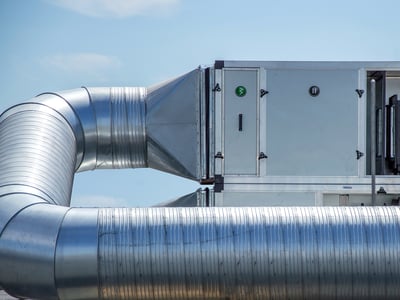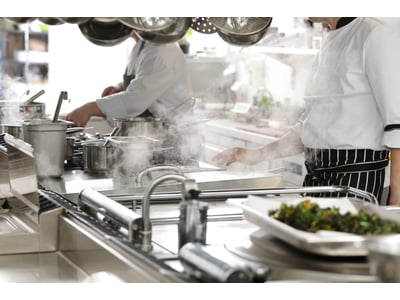Put clean indoor air on the menu at your restaurant – and minimize fire risk, eliminate odor nuisance and complaints, and increase customer loyalty by providing fresh, clean air.
Today, more and more people are going out to eat. They’re also rating their overall customer experience down to the most minute details. This increased traffic can bring in more profit, but also kitchen hazards. That’s why restaurants of all types need careful air management.
A busy commercial kitchen has quite different requirements than the “front of house” dining area, which requires a more comfortable, quiet ambiance. In the kitchen, a high-rate restaurant ventilation system is used to remove heat from cooking processes and collect smoke, steam and oil mist.
This air is typically dumped into atmosphere. Moving such contaminated air through buildings and discharging to the atmosphere attracts various risks, including:
Commercial kitchens are highly ventilated to remove heat, smoke and steam. Careful treatment of the exhaust air and supply air is essential to minimize fire risk, eliminate odor nuisance and provide paying guests with good air quality.
To mitigate the risks, the best solution is an appropriate combination of air filtration that coalesces oil and grease, collects fine particles and finally removes the gases responsible for odor. Loading of oil, grease, particulates and odor can be quite high in kitchen exhaust applications. After a successful installation, specified maintenance procedures must be followed to ensure ongoing effectiveness.
All the air that is removed from a kitchen and restaurant must be replenished. If not treated appropriately, this replacement outdoor air also brings associated risks to food hygiene, damage to finishes and furnishings, and of course the well-being of staff and diners. So, incoming air has got to be properly filtered to achieve high levels of indoor air quality (IAQ). For human protection, it is important that the smaller particle fraction, PM1, is effectively filtered with ePM1 filters according to ISO 16890.

Protect people, processes, products and equipment while keeping maintenance and energy costs low by keeping air handling units unclogged.

Customers want to eat at restaurants that control food safety and dining area cleanliness. Eliminate food preparation odors and particulates, and decrease the possibility of airborne food contamination and fire hazards from airborne oil vapors.

Commercial kitchens are highly ventilated to remove smoke, grease and stream. Exhaust filtration is used to minimize the risk of duct fires and remove odor nuisance.

Energy Cost Index (ECI) 5-Star Rating System set the standards for air filter performance. The more stars means better air filter performance and higher energy savings. Get recognized for saving energy, shrinking waste, reducing carbon footprint and improving indoor air quality.
Air quality Virus Contamination Control Electronics and optics Education and experience Commercial and public buildings Manufacturing and machinery Sustainability Take a Breath Case studies Food and beverage Life science and healthcare
In a scientific debate, WHO has acknowledged that in the case of COVID-19, airborne transmission could not be ruled out in crowded, closed or poorly ventilated settings. Scientists across the world are looking for more evidence as it may affect many guidelines in the crowded indoor environment.
Air quality Virus Contamination Control Commercial and public buildings Air cleaners and air purifiers Life science and healthcareCommon cold and flu remedies get passed down from generation to generation. From grandma’s chicken soup recipe to ginger and honey in tea, there are plenty of home remedies in every household. But some flu viruses are more serious and require stronger defenses.
CamCarb XG - engineered for energy and maintenance cost savings in molecular contamination control applications
Camfil is in the vanguard of a growing international movement to reduce the negative health effects of polluted air. As a leader in clean air solutions, we actively inform and educate customers, decision-makers, and the general public about threatening air pollutants and the tangible benefits of effective air filtration and high indoor air quality.
The food and beverage industry is affected by unique air quality challenges that can risk the health and safety of workers, production equipment along with a potential for contamination. Let’s look at how high-efficiency air filters can provide an effective and affordable solution.